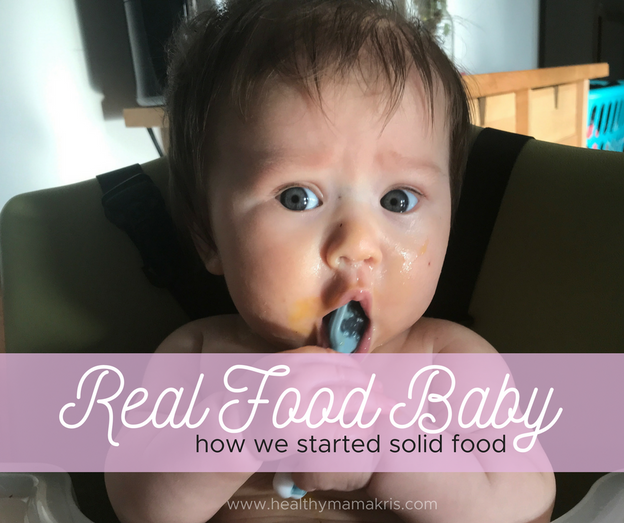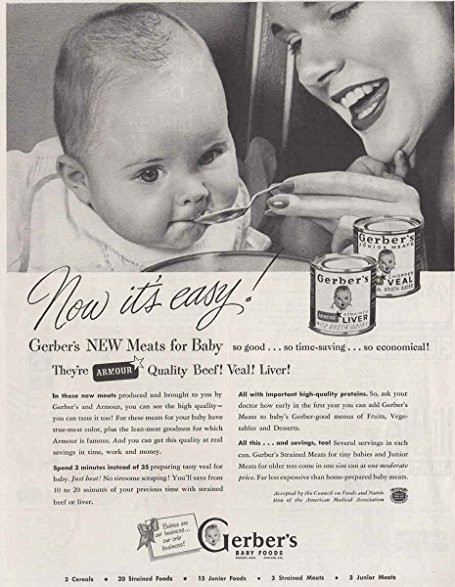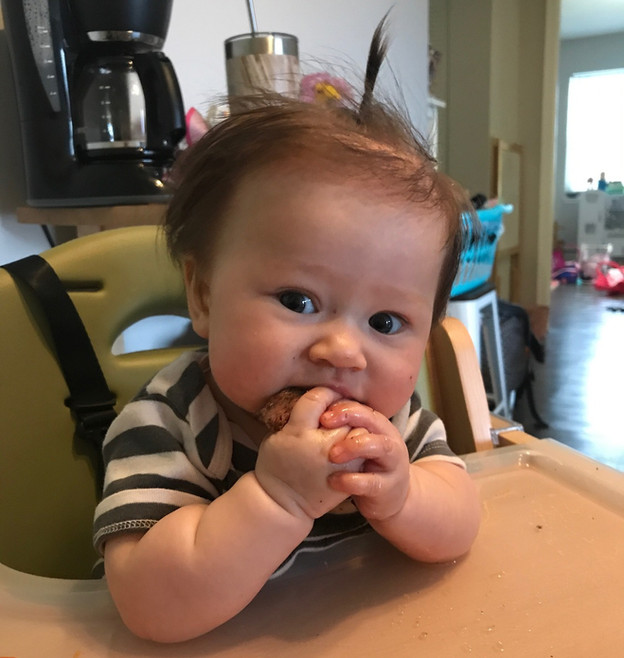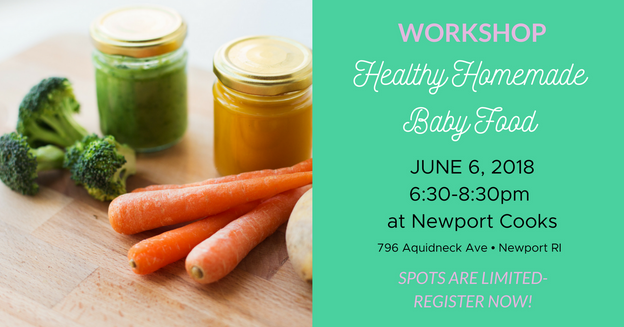This post contains affiliate links. By using these links you will be supporting Healthy Mama Kris at no additional cost to you. Thank you for supporting the healthy mama mission!

Last week I shared that we were about two weeks into our solid feeding journey and an overwhelming amount of you wanted to hear more! Local mamas: I am running a baby food class at Newport Cooks on June 6th which will be hands-on and super detailed! Lucky for you, I am happy to share more. First foods have been a passion of mine since my college Lifecycle Nutrition class, back almost ten years ago, now. Fascinatingly, MUCH has changed in the research and recommendations for infant feeding (even in between my two kids). So as both a nutritionist and a mama, I have done quite a bit of research into complementary foods and what foods are truly best for baby- and we’ve figured out a style of feeding that works best, for us. As with everything involving nutrition, I will never tell you there is one way that works for everyone! So what I aim to do is share with you what I’ve learned and what’s working for us, and open up the conversation about infant feeding, allowing you to draw your own conclusions as to how you would like to start solids with your baby; teaming with your pediatrician and utilizing the amazing resources that are out there for mamas to learn more about feeding your baby optimum first foods, setting them up for a lifetime of nourishment. So let’s dig in!
Starting Solids: The Case for Animals
I already talked about when we started solids, but I didn’t go much into why we started the way we did– with animal foods, rather than plant foods, which are what are most commonly given to babies at the start.
Years ago, the recommendation was to give babies rice cereal as a first food; the main reason being iron deficiency is a common problem in infants; and iron and zinc are the first major nutrients babies need (as iron stores drop significantly at 6 months, as do zinc). In fact, a 6-month old baby needs upwards of 4 times the iron of an adult man. However, iron from fortified foods, especially plant foods (like rice cereal) is absorbed less efficiently than that from whole foods. You might remember from biology class, there are two types of iron; heme and non-heme. Heme iron, absorbed and utilized readily by the body (otherwise known as bioavailabilty) comes from animal foods (meat, poultry, fish, seafood), and non-heme iron from plant foods (like grains, beans and leafy greens). Therefore the best (most bioavailable) source of iron (and zinc)? Animal foods like red meat, poultry, fish and organ meat. In fact, there is a phenomenon deemed the ‘meat factor’ that increases the absorption of iron from any source when meat is consumed. Non-heme and heme sources can be increased in bioavailabilty by the presence of Vitamin C, but not in an as-significant way as getting it from the source.
Megan Garcia has a fantastic resource of simple, homemade iron-rich recipes for baby.
Some of these foods- like liver pate and whipped bone marrow (which Wren LOVES, by the way) might seem unconventional to us now- but they’re actually quite traditional first foods babies were given for hundreds of years. It’s only been in recent years, around the time the (now disproven) low-fat health craze started, that we started giving babies fortified plant foods instead of naturally iron-rich animal foods.

(ad from 1949: source)
Breast milk or formula is a baby’s best and primary source of nutrition for the first twelve months of life; so why supplement with complementary food at all? To fill in the gaps- i.e. iron, zinc and other crucial nutrients, which is why I encourage so heavily starting with the most nourishing foods possible.
The issue with grains (it’s not what you think)
There are further issues with grains; as well as rice cereal specifically, and neither of them have to do with lacking the enzyme to break them down (something I had previously been taught and believed, as well). The fact is that amylase, the enzyme needed to break down starch, increases to adult levels between 6-12 months– and is needed to digest ALL starch, not just grains- sweet potato and other starchy vegetables included. Though babies can typically digest grains perfectly fine, grains and legumes do contain something called antinutrients, plant defense mechanisms which block the absorption of important minerals, including iron and zinc. A study done on 36 different grain-based infant cereal products showed that the antinutrient (phytates, specifically) content outweighed the mineral content; proving problematic. Another study compared sweet potato and maize (corn) based infant food, suggesting a far better bioavailability of nutrients, specifically minerals, with sweet potato over corn (a grain).
Sprouting or fermenting grains helps to reduce the antinutrient content to some extent and make them more digestible; so I recommend moms that do want to give their babies grains early on give their babies sprouted bread (if they so choose) or ferment their babies’ infant cereal (once babies are well into the feeding process, grains become less of an issue- unless they have a reaction or you have a history of gut or autoimmune issues; because they should be getting a wide variety of nutrients from a variety of sources).
The other issue with rice cereal specifically is one that has been in the news frequently as of late: arsenic. Arsenic is a naturally occuring heavy metal that is toxic in large doses and can cause severe cognitive, cardiac and cancer-causing effects. Rice is particularly high in arsenic, and like lead, there is NO safe limit set. The AAP recommends “parents offer their children a wide variety of foods, including other grains such as oats, wheat and barley, which will decrease their child’s exposure to arsenic from rice.” In fact, they specifically recommend meat as an alternative source of iron: “Parents commonly feed infants rice cereal as a first food, but other foods are equally acceptable as a first food. Finely chopped meat provides a source of iron.” (source)
This doesn’t, of course mean plant foods are out! At the beginning, I like to encourage 1-2 servings of iron and zinc rich animal foods as well as healthy fats (especially those crucial omega-3’s) daily; and fill in with delicious and vitamin-rich plant foods like vegetables and fruits. This doesn’t mean grains need to be out entirely; I just prefer to begin with foods that have more readily-available nutrients.

Baby Led vs. Parent-Fed
The next big question: self-feeding or purees? I sort of hover the line with this one. I believe self-feeding is a skill that is crucial to develop early; so practice is necessary, and babies who are ready to eat (more on this soon) will have the skills to begin to self-feed. I also believe self-feeding is the first step to intuitive eating, as babies get the choice of what they want to eat, eat to their fill and are not being shoved a spoon in their mouth beyond what they would normally consume. Sage began with pureed foods, and we moved on quickly to some self-feeding, but not as quickly as I think I would have if I had a do-over or had the right knowledge. For this reason, I decided to take the Feeding Littles Infant online course from the awesome Megan (a real food dietitian) and Judy (and occupational therapist specializing in feeding); both incredibly knowledgable and mamas themselves! This is not sponsored at all- I stumbled upon them on Instagram and was fascinated by their approach and couldn’t stop reading! I was so, so thankful I took the course, which went over all the basics of how to approach baby led weaning in a safe, developmentally friendly way. I highly recommend it!
On the other hand, I also believe some purees can be incredibly beneficial. As I outlined before, there are necessary nutrients babies need starting at 6 months. Food before one is not just for fun, as we were once led to believe! For this reason, we decided to incorporate soft spoon-fed and pureed foods to ensure Wren was getting the nutrients she needed, and this is what I recommend to mamas, as well- do what is comfortable for you; babies can get all they need through BLW, but it’s just a little more difficult.
So what foods did we start with?
One of the things I wanted to do this time around was really expand my education feeding beyond what I learned in college and nutrition school; so I decided to take Megan Garcia’s First Foods and Beyond course (yes, I took TWO infant feeding courses this time around! #nerd). I am SO glad I did! She is a wealth of knowledge; I highly, highly recommend her course and her work (you might notice I’ve referenced her a couple times) and I consider her THE expert on infant nutrition in the natural world. She has a degree in Chinese medicine and she is a mama herself; so she’s done this!
She has created the baby food pyramid, which I love (similar to my healthy family food pyramid, but for babies!), and outlines the foods, from most to least, babies benefit from i the first 6-24 months. Things some moms would never even think of, like fish roe, bone broth and sauerkraut.
Taking a nod from her recommendations, we started first with pastured egg yolk from our local farm; I soft cooked it and mixed it with a bit of breast milk and served it to her on a loaded ‘gootensil’ (as per Megan and Judy’s recommendations). I added a bit of dulse as per Megan’s recommendation for added minerals. From there, her next food was a hunk of (very lightly seasoned) grass-fed butcherbox steak . It just happened to be what we were eating, that night and she absolutely LOVED it, and I felt good about her getting in that all-important iron. I like sprinkling any iron-rich foods with acerola powder for a Vitamin C boost for increased bioavailabilty.
We started introducing vegetables and other proteins shortly after; making sure to always include a dose of healthy fats, as well. She loves roasted sweet potato spears with grass-fed ghee, apples lightly sauteed in coconut oil (though they were a little slippery to hold onto!) butcherbox burgers, smoked mackerel (yes!) and we introduced some purees/spoon foods, as well, including Megan Garcia’s whipped bone marrow recipe (super easy to make and incredibly iron and fat rich).

Introducing Allergens
This one deserves it’s own blog post, so I am working on that one for you! But to be brief, this is one HUGE thing that has changed in the last 10 years of nutritional science. The American Academy of Pediatrics now recommends early introduction of allergenic foods, due to recent studies, including the groundbreaking LEAP study on peanut allergies; and this one on egg introduction, concluding early introduction seems to be linked with a lower instance of allergies. We followed this recommendation, introducing one allergenic food every few days; waiting until we judged if she had a reaction or not. We waited until after the first round of allergenic foods to introduce soy and gluten; as these are foods that have been problematic for me in the past, and corn; which Nick and Sage are allergic to. She did end up having a skin reaction to egg white (egg yolk was no problem, which is common); so we will try again in a couple months and see where she is at. More on allergens, soon!
Resources
As always, I like to keep things simple and science-based, but these are my absolute favorite baby feeding resources:
1. Megan Garcia’s First Foods and Beyond course. WONDERFUL outline on infant nutrition and first foods, the baby’s food pyramid, foods by nutrient and by age- so many great (printable!) resources.
2. Feeding Little’s Infant Baby Led Weaning course. Again, FANTASTIC resource on how to go about baby led weaning the right way from two experts (and moms). Worth it’s weight in sweet potato fries!
3. Super Nutrition for babies. This is certainly not the conventional approach to feeding; which is one of the reasons I like it ;). Based on traditional foods and what our bodies truly need from a scientific standpoint.
Local Mamas: learn more and ask me all the questions! I’m sharing so much more about how to practically feed baby- purees, self-feeding, introducing different flavors, spices and more- in my healthy homemade baby food workshop at Newport Cooks! Join me

Sources:
https://www.ncbi.nlm.nih.gov/pmc/articles/PMC2528681/
https://academic.oup.com/jn/article/136/11/2808/4664211
https://onlinelibrary.wiley.com/doi/abs/10.1002/ajpa.22740
https://www.ncbi.nlm.nih.gov/pubmed/23812516
https://www.ncbi.nlm.nih.gov/pubmed/23167584
https://www.ncbi.nlm.nih.gov/pubmed/22594854
http://www.who.int/en/news-room/fact-sheets/detail/arsenic
https://www.health.harvard.edu/blog/fda-warns-parents-about-arsenic-in-rice-cereal-201604059473
https://www.aap.org/en-us/about-the-aap/aap-press-room/pages/AAP-Offers-Advice-For-Parents-Concerned-About-Arsenic-in-Food.aspx
http://www.aappublications.org/content/34/2/13
https://www.ncbi.nlm.nih.gov/pmc/articles/PMC4046529/
Early Introduction of Peanut Protects Against Allergy, LEAP Study Finds
https://www.jacionline.org/article/S0091-6749(10)01173-5/fulltext
Leave a Reply Cancel reply
5-day series: how to get started with meal prep for easier meals
free email series
©️ 2025 Kristin Dovbniak for Healthy Mama Kris | Template by Maya Palmer Designs | Privacy Policy | Terms
